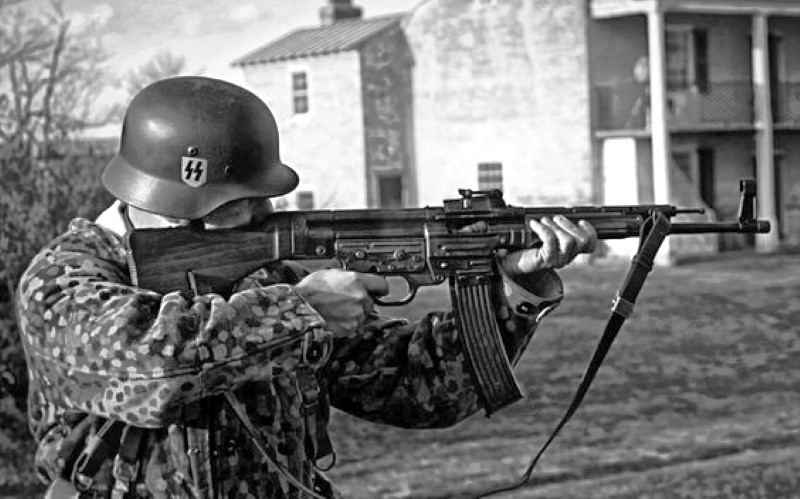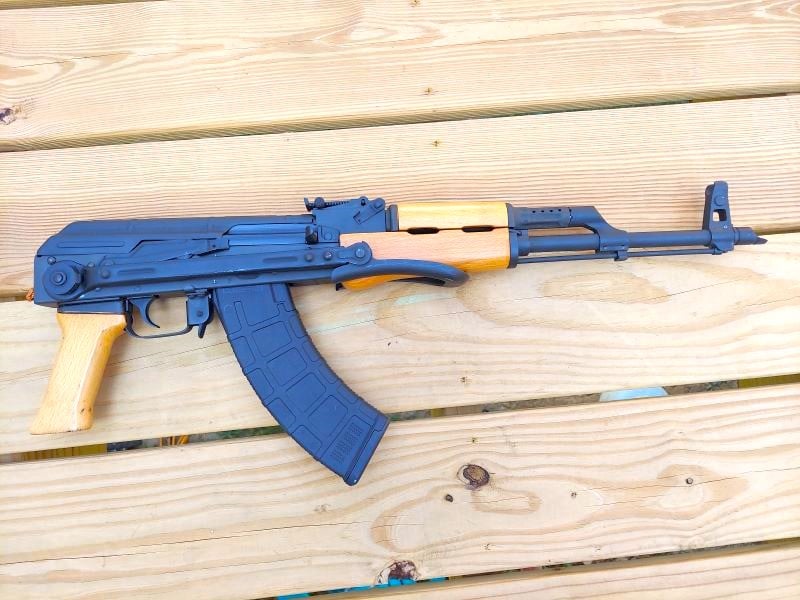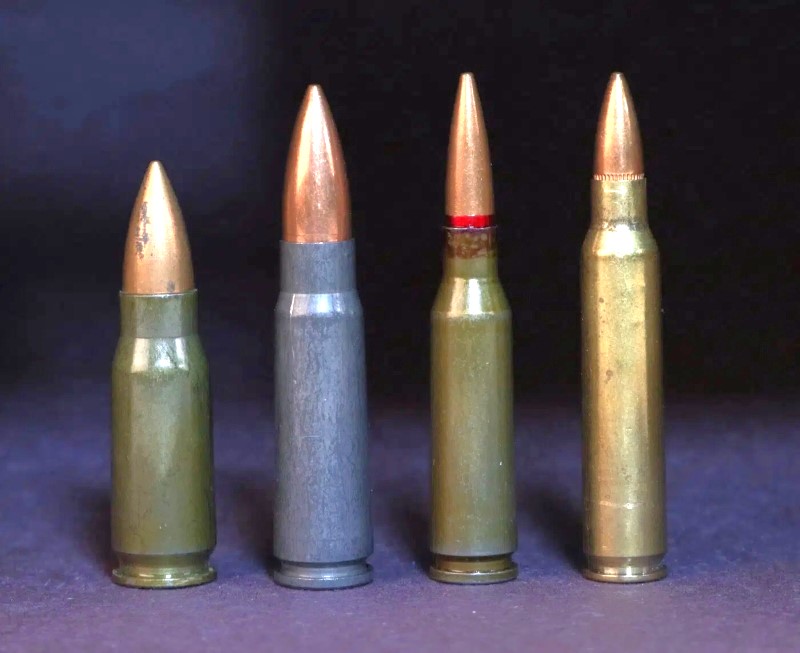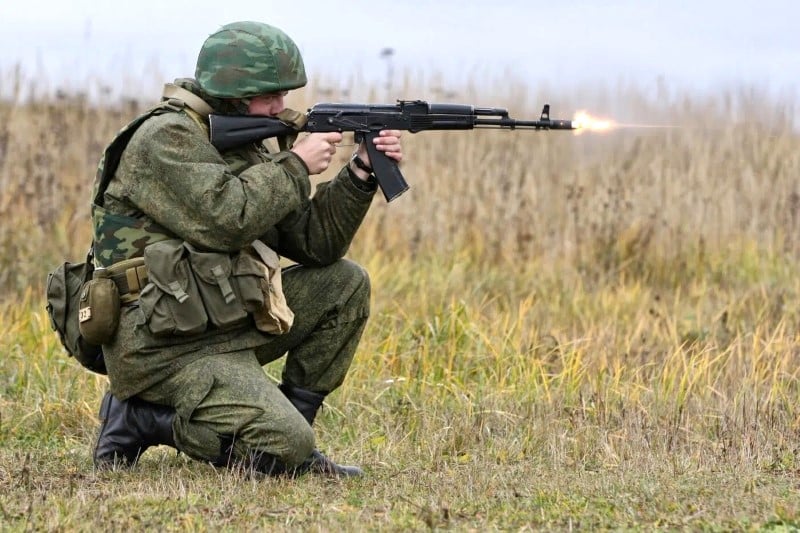Everyone has heard of the AK-47; it’s one of the most iconic firearms in the history of the world. Ironically, those who are not necessarily “gun people” might not know much about the AK-74. In fact, if you show a person a silhouette or a photo of the AK-74, they’ll often blurt out, “That’s an AK-47!”
Is there really a profound difference between the two? We’re about to boil it all down for you and give you the details.
Let’s take things from the beginning. Actually, we’ll start a little before the beginning.
Chalk it all up to German ingenuity.
Okay, I see you there in the back row, waving your hand around. You’re going to point out that the AK-47 is a Russian invention, not a German one.
Alright, dear reader, you’ve done some homework. But not all is as it seems. You see, World War II brought about some earth-shattering innovations as far as weapons were concerned. Especially in small arms. Despite their evil motivations, Germany proved to be a real innovator in new weapons concepts.
We’re going to focus on one of their particular weapons—the StG 44. The world’s first assault rifle.

The amount of thought that went into the StG 44 is surprising. The Germans figured out that most combat occurred within 300 meters, which meant their bolt action K98 rifles in 8mm Mauser were proving to be “overkill.” They didn’t need to engage targets, for the most part, out to 800 meters. At the same time, their 9mm submachine guns were adequate for close range (well under 100 meters) but were a little too limited out to the 300-meter requirement.
They needed a weapon that functioned at intermediate ranges, and thus, they developed the StG 44. It used what we now call an Intermediate Round—a 7.92×33 (Kurz) round weighing 125 grains and traveling at 2,250 feet per second. It could fire semi or fully automatic at a rate of 600 rounds per minute. Recoil was soft and the weapon was very controllable on full auto. The fact that it was easy to strip and clean in the field, along with its other attributes, garnered the love of those who used it in battle.
The Stg was more than a submachine gun, being able to reach out farther. It was less than a battle rifle, having a more limited range. However, it fit perfectly into the middle ground that was needed at the time.
Enter The Russkies
Russia certainly took notice, as they realized this concept had some serious merit.
They developed the 7.62x39mm cartridge, which hurls a 123-grain projectile approximately 2,350 feet per second. That’s very similar to the German round for the StG 44. The Russians realized that the Germans’ battle requirements for the round were very intelligent and reasonable. Why not copy the concept? Russia wasn’t too proud. The Russian bullet was designated the M43, as it was invented in 1943.
The Soviet SKS carbine chambered the new 7.62x39mm M43 round. But the SKS was only a stop-gap, a step in the progression of the weapons family. The Russians realized they wanted more than just a 10-shot carbine.
It was already on the way. Back in 1941, when machinist Mikhail Kalashnikov was recovering from wounds he suffered in battle, he designed the AK-47. I’m simplifying things here—the design underwent some revisions. The “47” was designated because that was the first year that the assault rifle went into production. While it shares some external similarities with the StG 44, internally it is different.
The AK-47
Some general specifications of the AK-47 are that it weighs around 7.7 pounds in standard form with fixed, wooden stock, and has an overall length of 35 inches. The folding stock version has an overall length of 34.4 inches when the stock is extended and 25.4 inches when folded.
Like its StG 44 predecessor, the AK-47 makes extensive use of stampings, which means it’s cheap and easy to produce. The receivers are made from stampings and there are also ones made from milled steel.

The AK-47’s rate of fire is around 600 rounds per minute (again, similar to the StG 44), with an effective range listed at about 380 meters. Personally, I think that’s optimistic. The AK is not known for its accuracy. Don’t get me wrong, it’s effective enough at combat ranges, but going past 250 yards with one becomes a proposition of luck, in my opinion.
The AK-47’s magazines are standard at 30 rounds, but other options are available, including 20-round magazines and 75-round drums.
The AK’s durability and reliability, of course, are legendary. Perhaps even best described as mythical. Regardless of how fabled it might be, they definitely are ultra-reliable. AKs can take some extraordinary abuse. And they should be able to since they were designed to be issued mainly to conscripts who are unmotivated and poorly educated. Let’s just say, these peoples’ first priorities are often not in taking care of their issued weapons.
Terrorists who live in remote areas with virtually no gun cleaning supplies or know-how also love the AK-47 for this reason; they can endlessly abuse them, and the AK still keeps working most of the time.
Recoil is manageable with the AK platform in its 7.62x39mm caliber. The folding stock models look cool and are great for storing in smaller places such as vehicles, aircraft, etc. However, they’re not as comfortable to fire on the range as their fixed, wooden-stocked brethren are.
A huge portion of the world uses the AK-47. Dozens upon dozens of countries use them in one form or another. And, as mentioned, it’s the weapon of choice for many terrorists. And the AK-47 spawned other weapons. Light machineguns such as the RPD (belt fed) and RPK (magazine fed) cropped up and function as Squad Automatic Weapons.
Despite the fact that Russia has replaced the AK-47 officially, it can still be found in staggering numbers on the battlefield today all over the world, in every conflict imaginable. Russia supplied weapons to all of our enemies, including the Chinese and the North Vietnamese. As such, our troops faced the AK-47 daily in Viet Nam.

Copying Again
Russia, being the reliable copycat that they are, took notice of our 5.56x45mm cartridge that the M-16 family of weapons fired. Seeing the merit of a lighter round, they began working on their own. Apparently, a flat-shooting, lighter-weight cartridge appealed to them. Troops could carry more rounds that weighed less, which is a good thing on the battlefield. The lower recoil was also an added bonus.
Enter the AK-74
No, it’s not a typo—the AK-47 became the AK-74. The new AK-74 utilized the 5.45x39mm round, which fires a 53-grain projectile at 2,790 feet per second. This cartridge was under development by Russian engineers in the early 1970s.
The AK-74’s rate of fire is approximately 650 rounds per minute. Considering it has less recoil than its bigger brother, it is more controllable. The AK-74 fires using a standard 30-round magazine, though there are plenty of aftermarket options with greater capacity.
Basically, it is very similar to the AK-47, with some small changes. The AK-74’s magazine doesn’t have as much of a curve to it as the AK-47’s does. Early magazines were made of a substance referred to as “Bakelite,” which has an orange hue to it.
A large muzzle brake is mounted on the end of the barrel as well, to further tame the recoil/muzzle rise of the gun. This is actually probably the easiest way to differentiate the ’74 from the ’47 (gets confusing, doesn’t it—try typing it over and over). The first AK-74s looked very similar to the AK-47.

A folding stocked version, the AKS-74 was also introduced. It featured a side folding stock that was sheet metal in a triangular pattern. This was an improvement over the under-folding stock used by the AK-47.
Around 1977, the AK-74’s gas block was changed from 45 degrees to 90 degrees because of bullet shear. Apparently, the 45-degree block was shearing the higher-velocity bullets as they traveled down the barrel.
From the beginning of production, the AK-74 featured laminated wood handguards and buttstocks. The pistol grip was Bakelite. However, for a time, plumb-colored fiberglass-reinforced plastic was utilized. Then, in 1989, the AK-74’s furniture turned black, and that has been the color that it stayed since then.
1991 saw the next big advance in AK-74 design: the AK-74M. This new model had several advanced features, including a side-folding buttstock, a modified muzzle brake, and a receiver-mounted side rail for mounting optics. This model’s side-folding stock is solid, in contrast with the original metal, triangular folder.
Aside from the standard models of AK-74, there is also a shortened version (with side folding stock) called the AK-74U and an RPK-74 Squad Automatic Weapon.

The AK-74M remains in service to this day with the Russians and by a wide host of other countries. Ironically, the defenders of Ukraine are using Russian AK-74s against their Russian invaders as I type this.
Parting Shots
So now you know the full story. While the AK-47 and the AK-74 share many similarities, the AK-74 has clearly pulled ahead in the design and improvement department. It is a more efficient weapon than the AK-47 due to its flatter shooting, lighter cartridge, exhibiting better accuracy and less recoil.
And it all started back in World War II with the Germans and their innovation. It reminds me of that old saying, the more things change, the more they stay the same.


